Experimental Performance Study of Solar-Assisted Enhanced Vapor Injection Air-Source Heat Pump System
Abstract
1. Introduction
2. Experimental System and Theoretical Analysis
2.1. Test Device
2.2. Thermodynamic Cycle Analysis
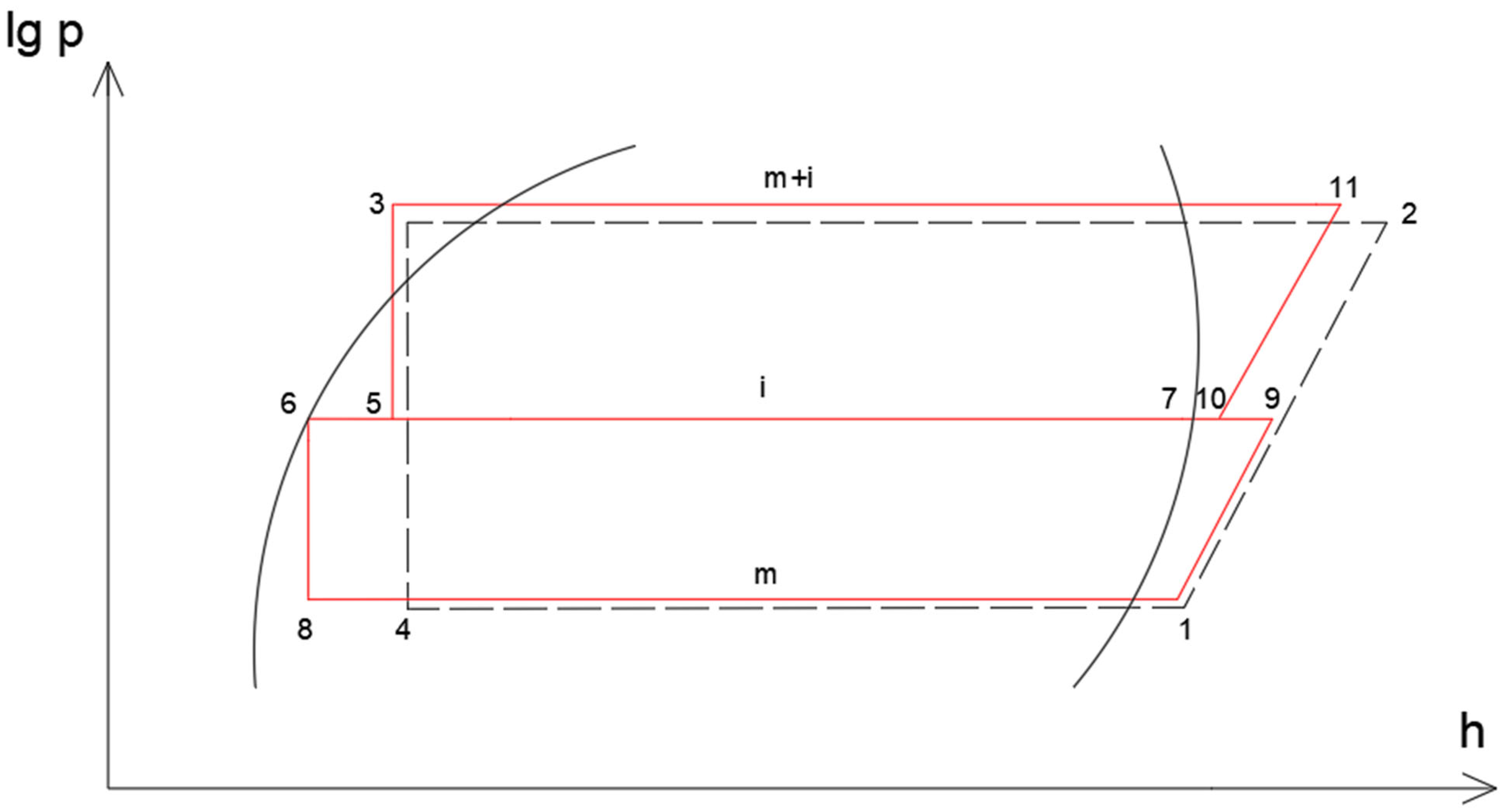
3. Experimental Scheme Design
3.1. Performance Analysis of the SC-EVIHP System for a Typical-Weather Day
3.2. Study of the Operational Regulation of the SC-EVIHP System
4. Experimental Results and Analysis
4.1. Experimental Study of the SC-EVIHP System on a Typical-Weather Day in Winter
4.2. Study of Operational Performance of the SC-EVIHP System
5. Economic Analysis
6. Conclusions
- (1)
- The SC-EVIHP system is greatly affected by solar radiation intensity. In the experiment regarding a typical meteorological day in winter, the maximum outlet temperature of the solar air collector appeared at 12 o’clock; at this time, the heating capacity and COP of the SC-EVIHP system were reaching their maximum value. Compared with the conventional EVI-ASHP system, the heating capacity and COP of the SC-EVIHP system were improved by 24.9% and 12.5%, respectively.
- (2)
- In the conditions using hot air at different temperatures, the heating capacity and COP of the SC-EVIHP system increased by 3.9~10.9% and 6.1~11.1%, respectively. When the outdoor temperature was −12 °C and the hot air temperature was 40 °C, the COP of the SC-EVIHP system increased by 11.1% at most and still increased by 10% at the extreme outdoor temperature of −20 °C.
Author Contributions
Funding
Data Availability Statement
Conflicts of Interest
References
- Wang, Y.; Rao, Z.; Liu, J.; Liao, S. An optimized control strategy for integrated solar and air-source heat pump water heating system with cascade storage tanks. Energy Build. 2020, 210, 109766. [Google Scholar] [CrossRef]
- Huang, S.; Zuo, W.; Lu, H.; Liang, C.; Zhang, X. Performance comparison of a heating tower heat pump and an air-source heat pump: A comprehensive modeling and simulation study. Energy Convers. Manag. 2019, 180, 1039–1054. [Google Scholar] [CrossRef]
- Fan, Y.; Li, J.; Zhao, X.; Myers, S.; Cheng, Y.; Yu, M.; Akhlaghi, Y.G.; Ma, X.; Yu, S. A proof-of-concept study of a novel ventilation heat recovery vapour injection air source heat pump. Energy Convers. Manag. 2022, 256, 115404. [Google Scholar] [CrossRef]
- Zhu, J.H.; Sun, Y.Y.; Wang, W.; Deng, S.M.; Ge, Y.J.; Li, L.T. Developing a new frosting map to guide defrosting control for air-source heat pump units. Appl. Therm. Eng. 2015, 90, 782–791. [Google Scholar] [CrossRef]
- Wang, W.; Feng, Y.C.; Zhu, J.H.; Li, L.T.; Guo, Q.C.; Lu, W.P. Performances of air source heat pump system for a kind of mal-defrost phenomenon appearing in moderate climate conditions. Appl. Energy 2013, 112, 1138–1145. [Google Scholar] [CrossRef]
- Wang, W.; Xiao, J.; Guo, Q.C.; Lu, W.P.; Feng, Y.C. Field test investigation of the characteristics for the air source heat pump under two typical mal-defrost phenomena. Appl. Energy 2011, 88, 4470–4480. [Google Scholar] [CrossRef]
- Yan, G.; Bai, T.; Yu, J. Energy and exergy efficiency analysis of solar driven ejector–compressor heat pump cycle. Sol. Energy 2016, 125, 243–255. [Google Scholar] [CrossRef]
- Jie, X.; Xianmin, G.; Liping, X. Experimental Study on Performance of Flash-tank Vapor Injection Air-Source Heat Pump System with Refrigerant R32. Energy Procedia 2017, 142, 950–956. [Google Scholar] [CrossRef]
- Han, X.; Zou, H.; Kang, W.; Xu, H.; Chen, Y.; Tian, C. Experimental investigation on vapor injection ASHP for electric rail vehicles in cold region. Appl. Therm. Eng. 2019, 153, 473–482. [Google Scholar] [CrossRef]
- Wei, W.; Ni, L.; Dong, Q.; Wang, W.; Ye, J.; Xu, L.; Yang, Y.; Yao, Y. Experimental investigation on improving defrosting performance of air source heat pump through vapor injection. Energy Build. 2022, 256, 111696. [Google Scholar] [CrossRef]
- Heo, J.; Kang, H.; Kim, Y. Optimum cycle control of a two-stage injection heat pump with a double expansion sub-cooler. Int. J. Refrig. 2012, 35, 58–67. [Google Scholar] [CrossRef]
- Wang, J.; Qv, D.; Yao, Y.; Ni, L. The difference between vapor injection cycle with flash tank and intermediate heat exchanger for air source heat pump: An experimental and theoretical study. Energy 2021, 221, 119796. [Google Scholar] [CrossRef]
- Li, W.; Liu, R.; Liu, Q.; Liu, Y.; Wang, D.; Xia, S.; Shi, J.; Chen, J. Upstream and downstream injection effects on R134a economized vapor injection heat pump system at low temperatures for electric vehicles. Int. J. Refrig. 2020, 120, 1–11. [Google Scholar] [CrossRef]
- Jia, S.; Shan, S.; Zhang, F.; Liu, B.; Zhang, Q.; Zhou, Z. Parametrical analysis of a novel CHP system based on solar-gas assisted thermo-photovoltaic device. Energy Convers. Manag. 2022, 271, 116316. [Google Scholar] [CrossRef]
- Wang, D.; Chen, R.; Zhou, Y.; Wang, Y.; Liu, Y. Optimization and techno-economic analysis of combined gas-fired boiler and solar heating system for capacity-increase cities. Sol. Energy 2022, 243, 225–235. [Google Scholar] [CrossRef]
- Aligholami, M.; Khosroshahi, S.S.; Khosroshahi, A.R. Hydrodynamic and thermodynamic enhancement of a solar chimney power plant. Sol. Energy 2019, 191, 180–192. [Google Scholar] [CrossRef]
- Yang, L.W.; Hua, N.; Pu, J.H.; Xia, Y.; Zhou, W.B.; Xu, R.J.; Yang, T.; Belyayev, Y.; Wang, H.S. Analysis of operation performance of three indirect expansion solar assisted air source heat pumps for domestic heating. Energy Convers. Manag. 2022, 252, 115061. [Google Scholar] [CrossRef]
- Wang, Z.; Chen, H.; Sun, X.; Lu, H.; Wang, T. Optimizing the solar-air hybrid source heat pump heating system based on the particle swarm algorithm. Energy Rep. 2022, 8, 379–393. [Google Scholar] [CrossRef]
- Long, J.; Xia, K.; Zhong, H.; Lu, H.; Yongga, A. Study on energy-saving operation of a combined heating system of solar hot water and air source heat pump. Energy Convers. Manag. 2021, 229, 113624. [Google Scholar] [CrossRef]
- Xu, W.; Liu, C.; Li, A.; Li, J.; Qiao, B. Feasibility and performance study on hybrid air source heat pump system for ultra-low energy building in severe cold region of China. Renew. Energy 2020, 146, 2124–2133. [Google Scholar] [CrossRef]
- Januševičius, K.; Streckienė, G.; Bielskus, J.; Martinaitis, V. Validation of unglazed transpired solar collector assisted air source heat pump simulation model. Energy Procedia 2016, 95, 167–174. [Google Scholar] [CrossRef]
- Xu, S.; Niu, J.; Cui, Z.; Ma, G. Experimental research on vapor-injected heat pump using injection subcooling. Appl. Therm. Eng. 2018, 136, 674–681. [Google Scholar] [CrossRef]
- Yu, M.; Yu, J. Thermodynamic analyses of a solar assisted ejector enhanced vapor injection cycle with subcooler for heat pump dryer application. Sol. Energy 2022, 232, 376–387. [Google Scholar] [CrossRef]
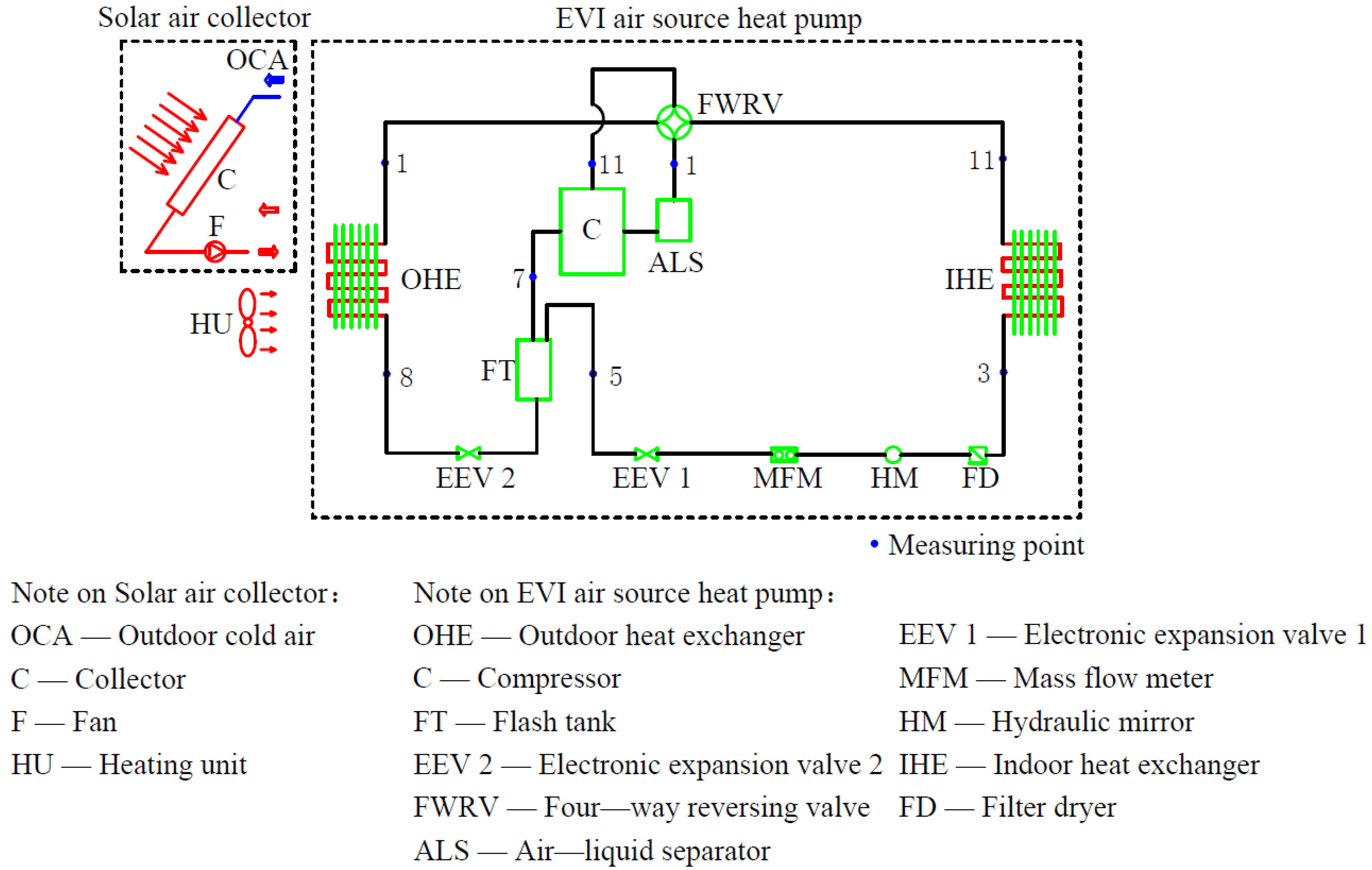
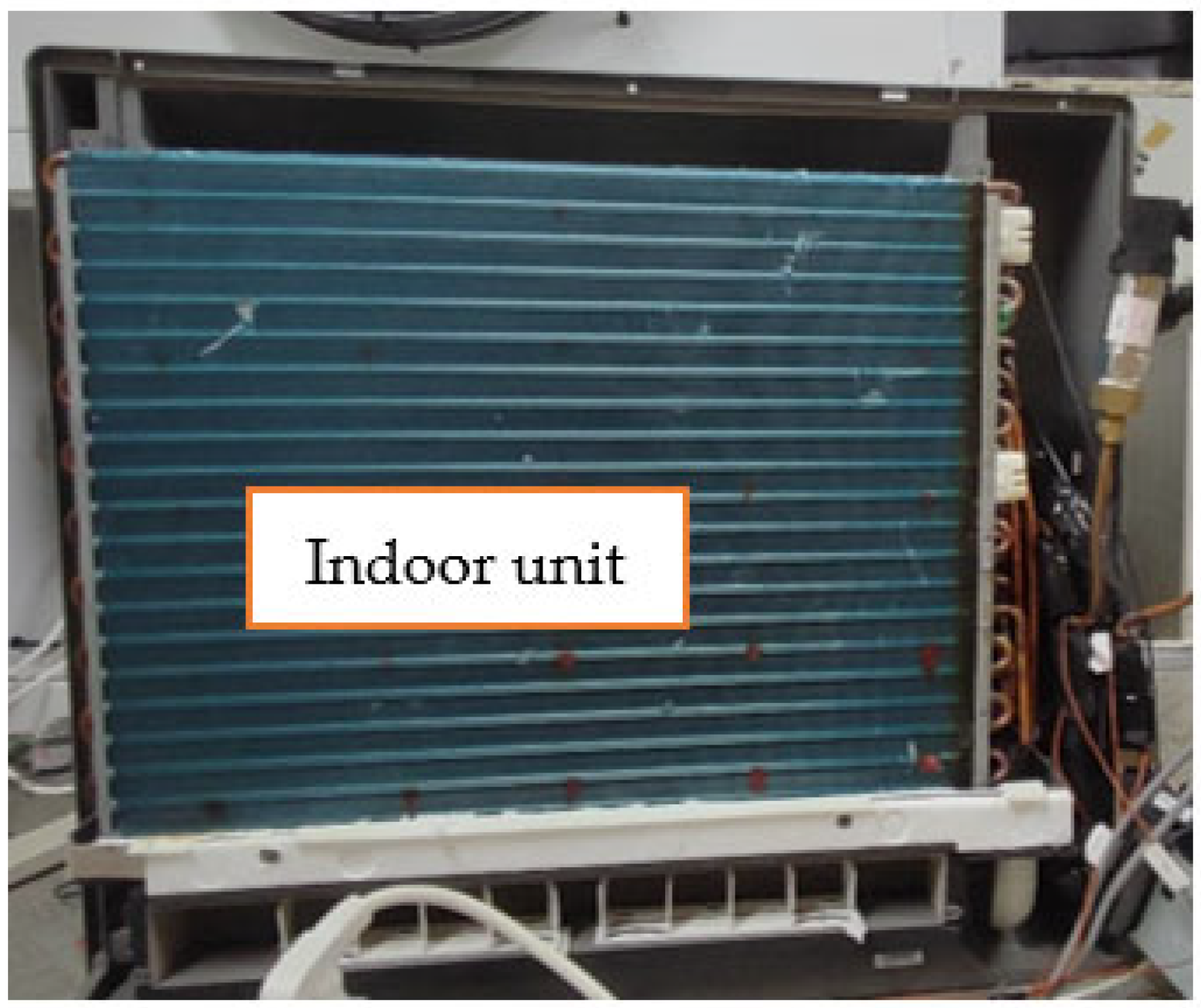
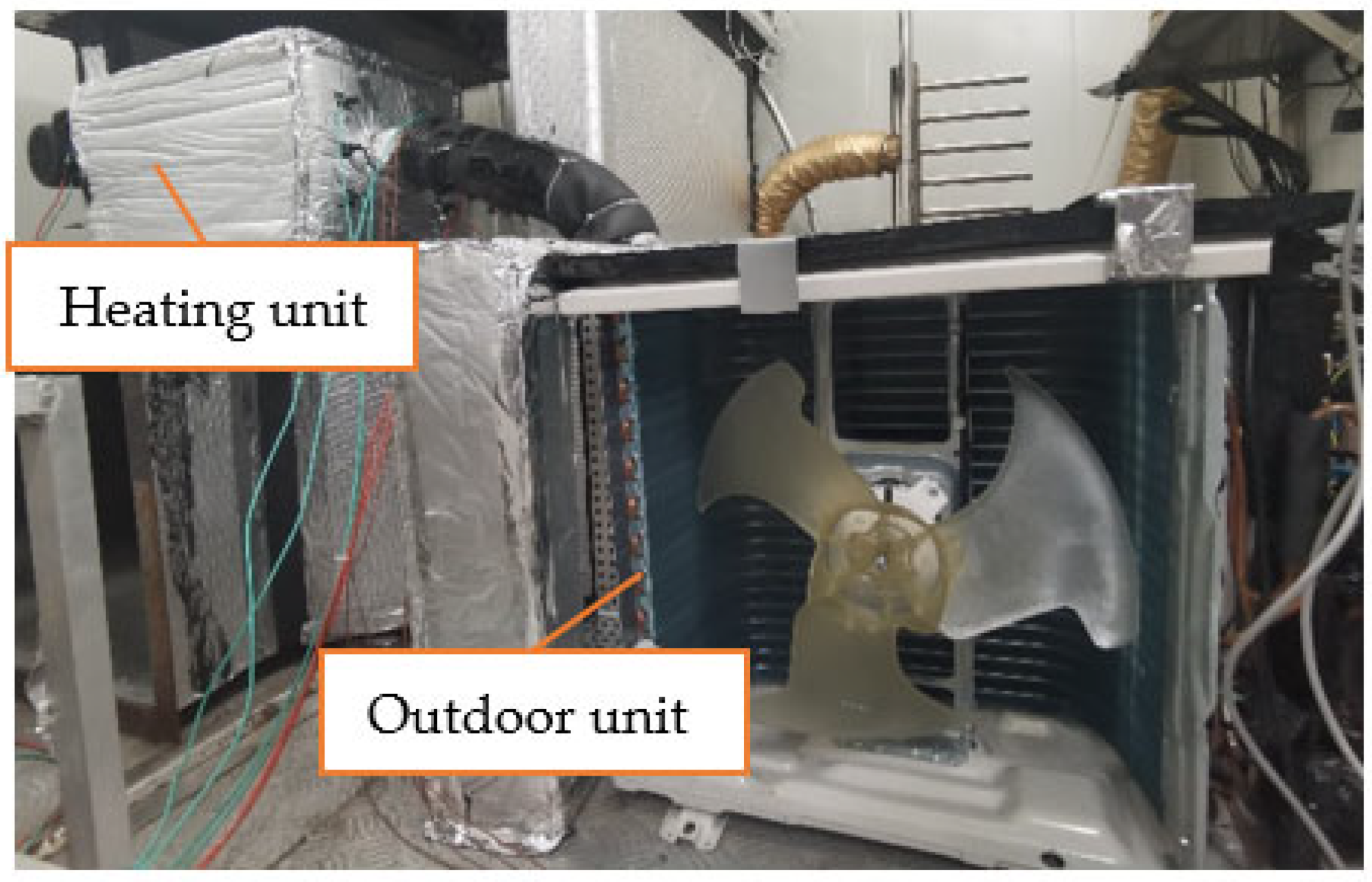
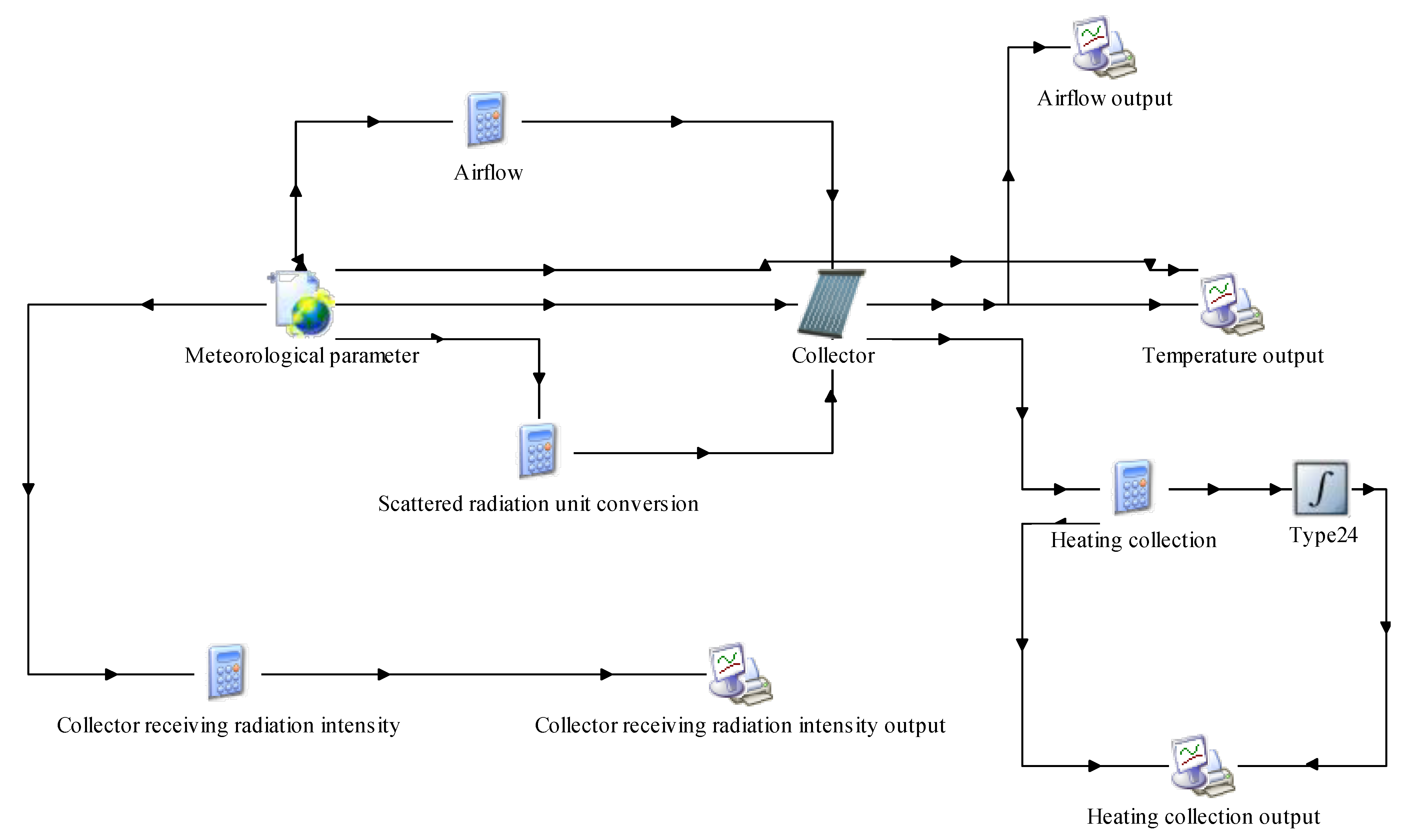
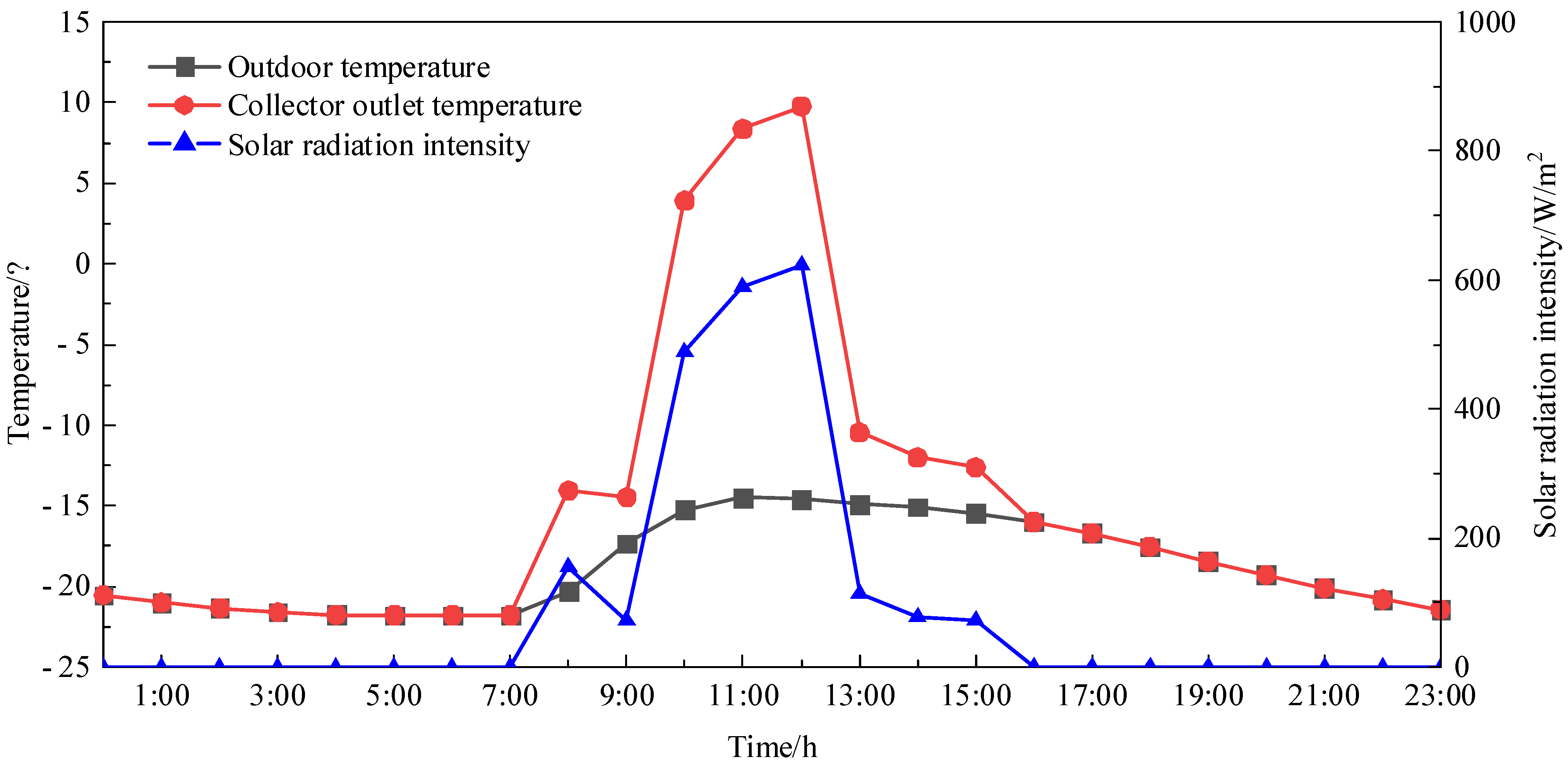
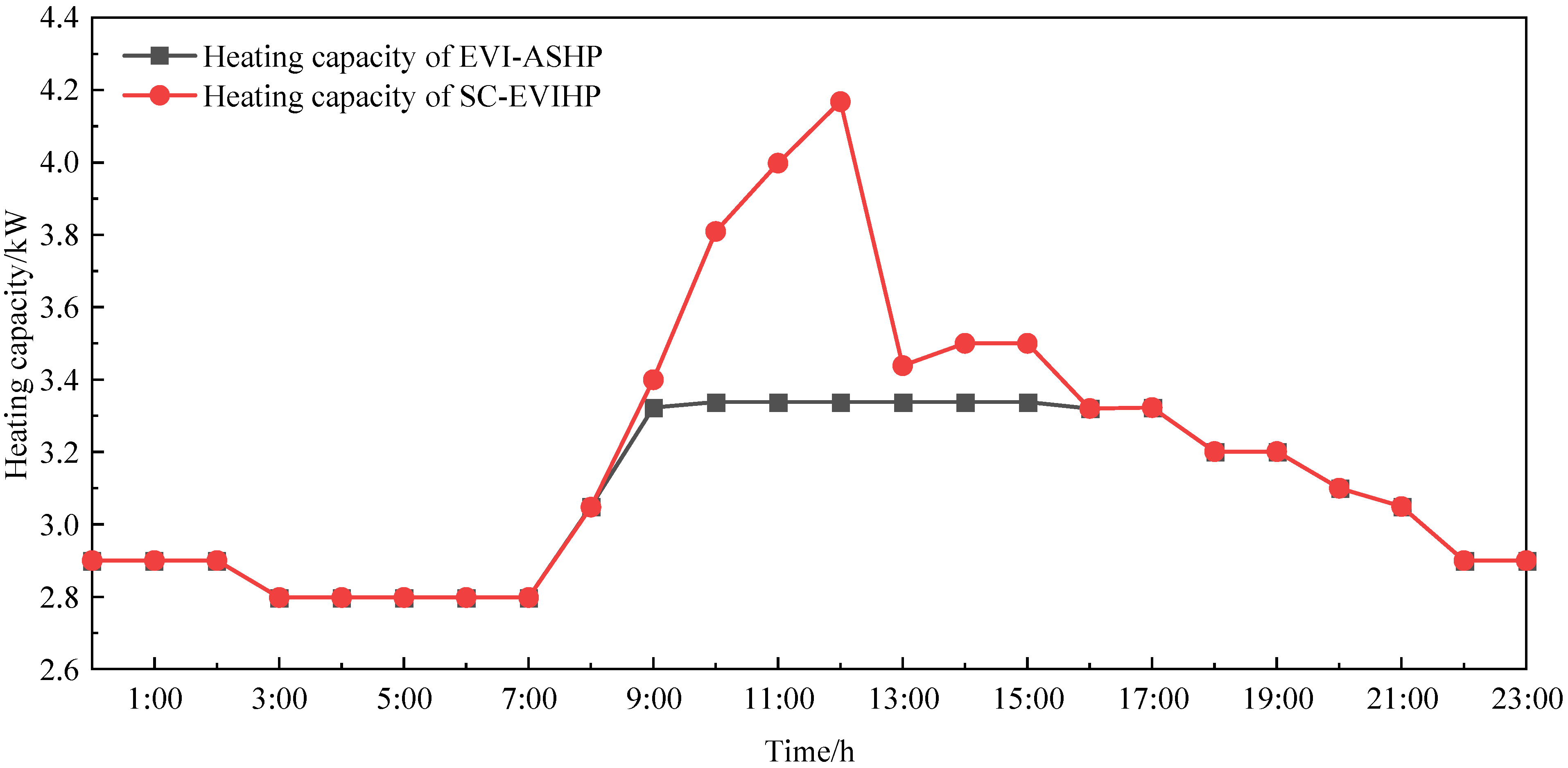
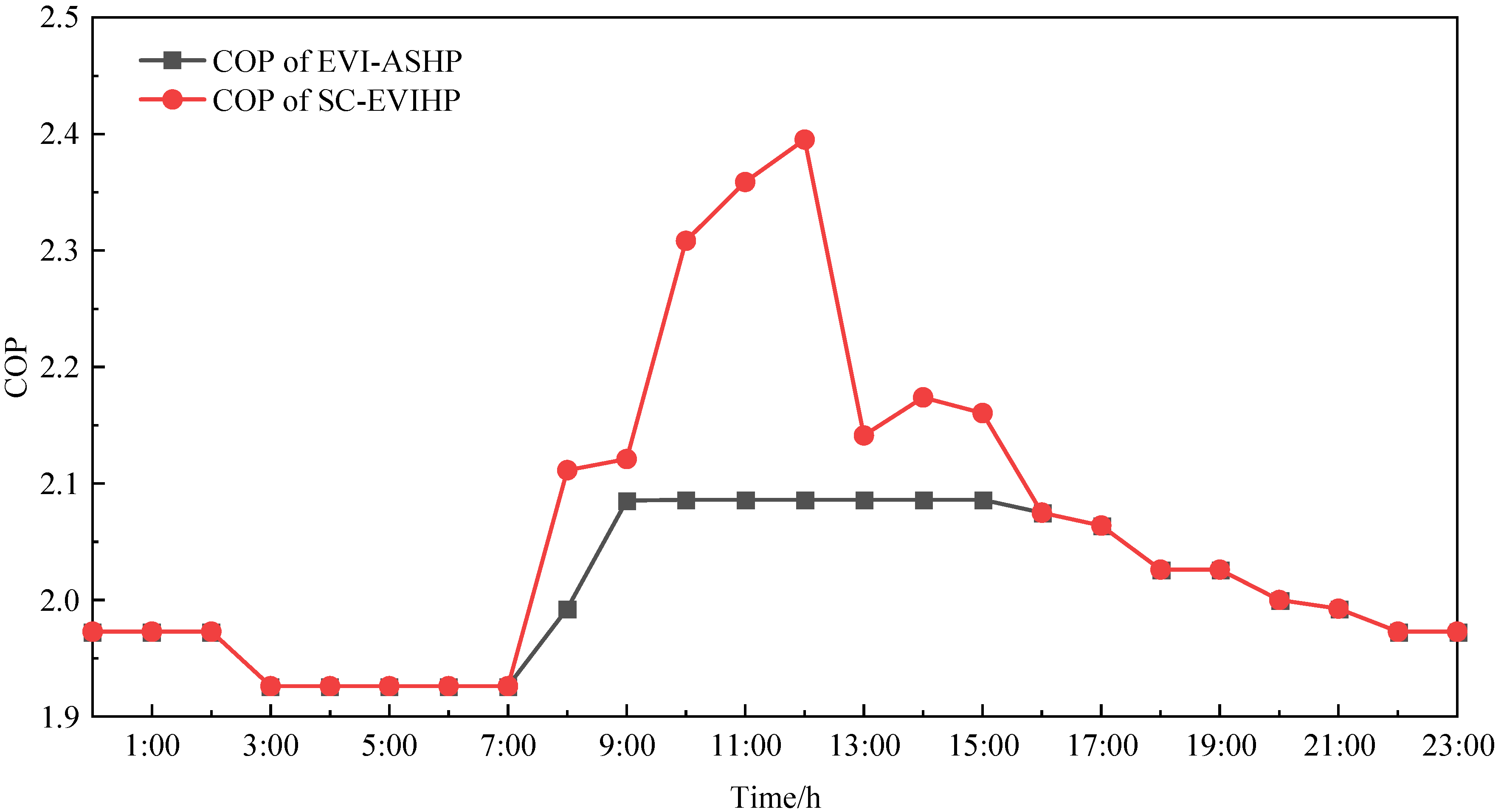

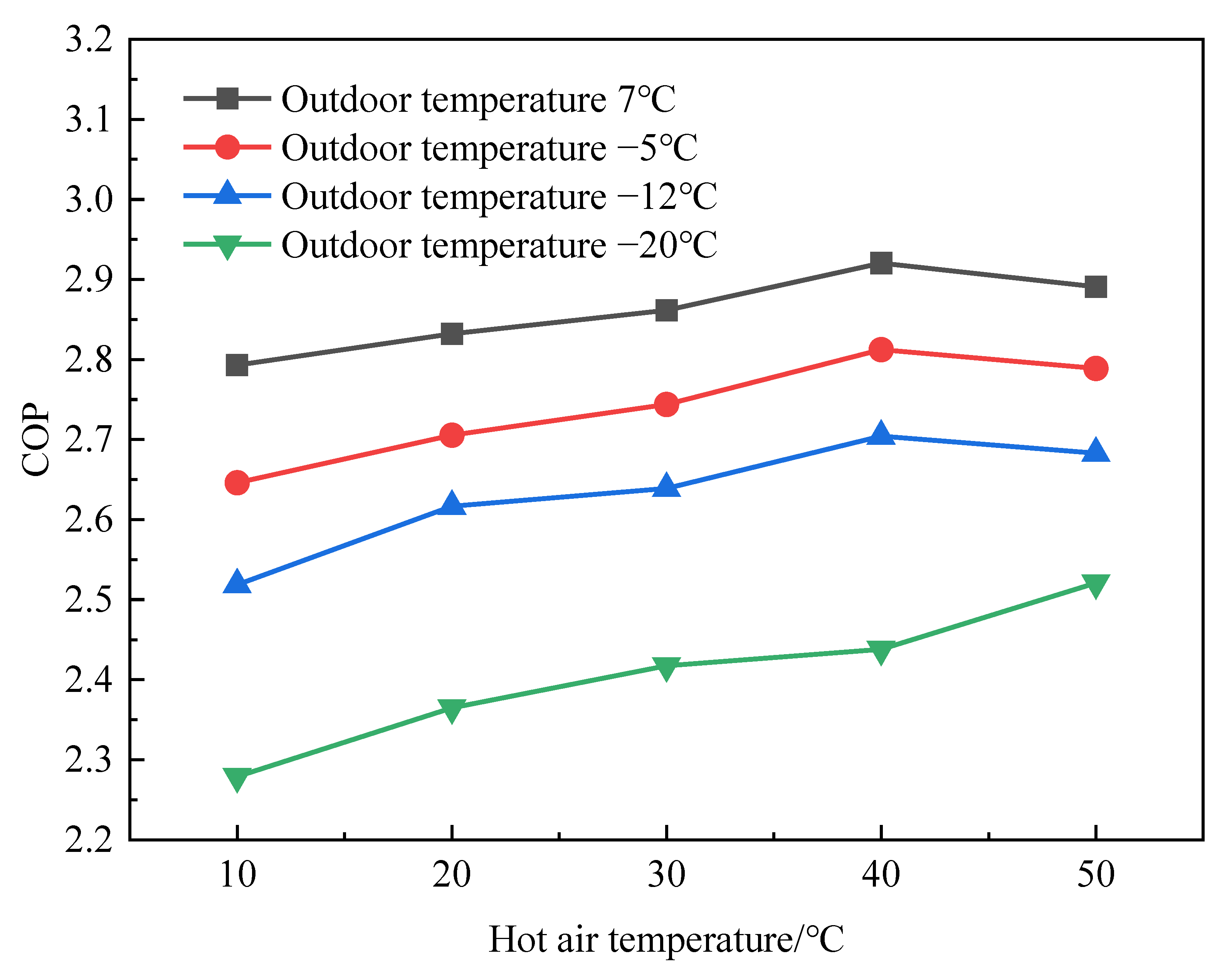

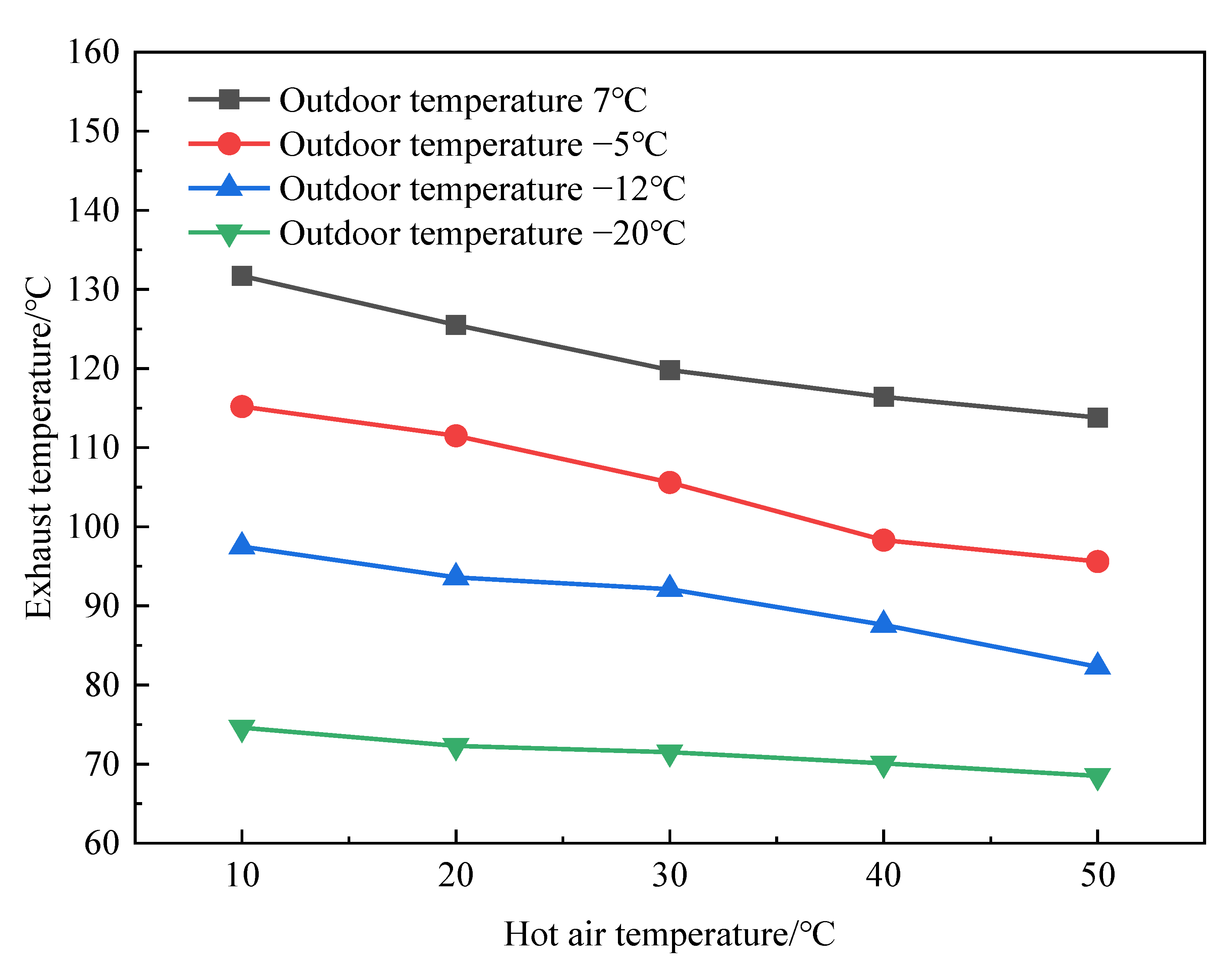
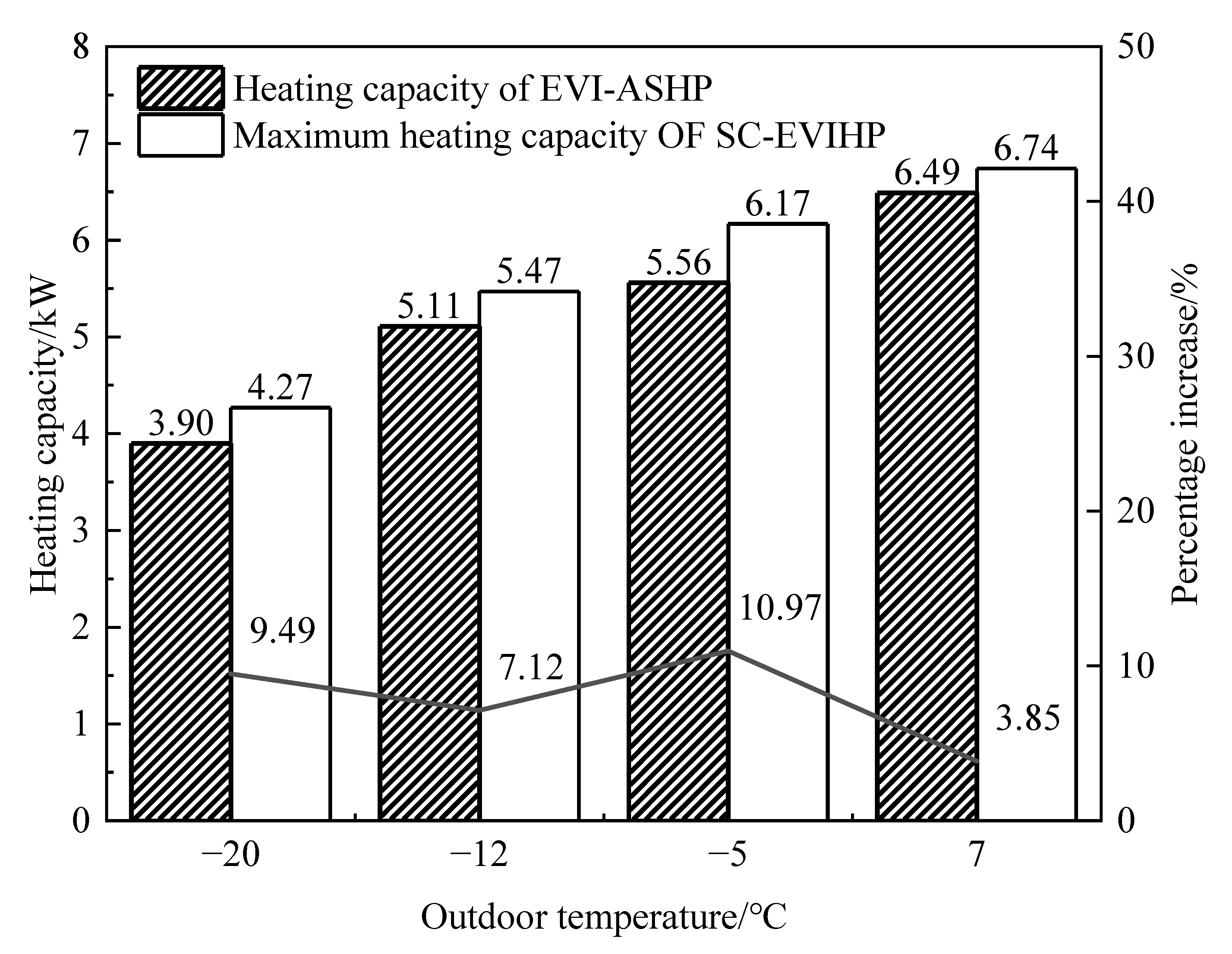
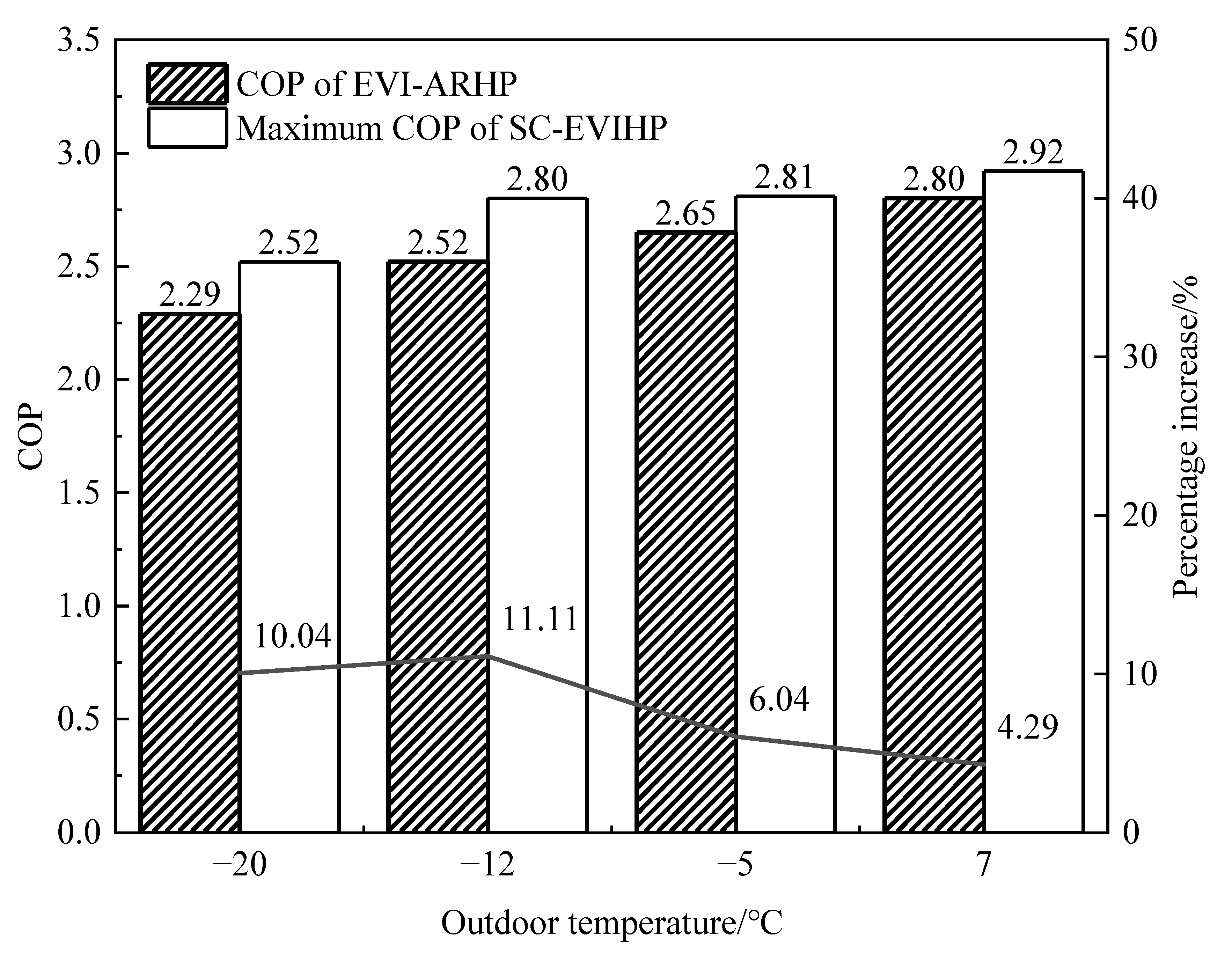
| Testing Instrument | Product Model | Range | Accuracy |
|---|---|---|---|
| T-type thermocouples | SH-T | −99.9~300 °C | ±0.15 °C |
| Diffusible silicon pressure transducer | MIKP300 | 0–5 MPa | 0.25 class |
| Mass flow meter | RHM18913 | 0~1.7 kg/s | ±0.2% |
| Three-phase electronic measurement and control meter | TP612 | 0~756,000 kW | 0.5 class |
| Filter dryer | DFS-083S | - | - |
| Hydraulic mirror | SYJ6 | - | - |
| Indoor Side | Outdoor Side | ||||
|---|---|---|---|---|---|
| Dry-bulb temperature/°C | 20 | −20 | −12 | −5 | 7 |
| Wet-bulb temperature/°C | 15 | - | −13.5 | −1 | 6 |
| Outdoor Temperature/°C | Indoor Temperature/°C | Heating Capacity/kW | Power Consumption/kW | COP |
|---|---|---|---|---|
| −20 | 20 | 3.90 | 1.70 | 2.29 |
| −12 | 20 | 5.11 | 2.03 | 2.52 |
| −5 | 20 | 5.56 | 2.10 | 2.65 |
| 7 | 20 | 6.49 | 2.32 | 2.80 |
| SC-EVIHP System | Conventional EVI-ASHP System | |
|---|---|---|
| Initial equipment Investment/USD | 1190 | 560 |
| Labor cost/USD | 140 | 70 |
| Annual operating cost/USD | 201.6 | 312.5 |
Publisher’s Note: MDPI stays neutral with regard to jurisdictional claims in published maps and institutional affiliations. |
© 2022 by the authors. Licensee MDPI, Basel, Switzerland. This article is an open access article distributed under the terms and conditions of the Creative Commons Attribution (CC BY) license (https://creativecommons.org/licenses/by/4.0/).
Share and Cite
Li, Z.; Du, Y.; Pan, Y.; Zhang, F.; Meng, Z.; Zhang, Y. Experimental Performance Study of Solar-Assisted Enhanced Vapor Injection Air-Source Heat Pump System. Energies 2022, 15, 7730. https://doi.org/10.3390/en15207730
Li Z, Du Y, Pan Y, Zhang F, Meng Z, Zhang Y. Experimental Performance Study of Solar-Assisted Enhanced Vapor Injection Air-Source Heat Pump System. Energies. 2022; 15(20):7730. https://doi.org/10.3390/en15207730
Chicago/Turabian StyleLi, Zhengrong, Yongheng Du, Yuqin Pan, Fan Zhang, Zhaofeng Meng, and Yanan Zhang. 2022. "Experimental Performance Study of Solar-Assisted Enhanced Vapor Injection Air-Source Heat Pump System" Energies 15, no. 20: 7730. https://doi.org/10.3390/en15207730
APA StyleLi, Z., Du, Y., Pan, Y., Zhang, F., Meng, Z., & Zhang, Y. (2022). Experimental Performance Study of Solar-Assisted Enhanced Vapor Injection Air-Source Heat Pump System. Energies, 15(20), 7730. https://doi.org/10.3390/en15207730





